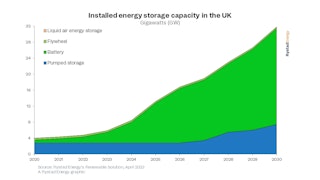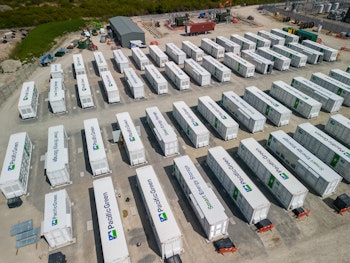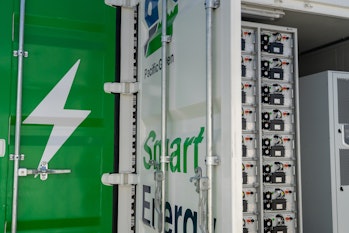The press release that analyst firm Rystad Energy put out in April 2023 was music to the ears of anyone in the energy storage sector. The UK’s battery storage market is expected to see “exponential growth,” said Rystad Energy, hitting 24 GW by the end of the 2020s from 4.7 GW today.
“These utility-scale battery systems will attract investments of up to $20 billion and have enough combined energy reserves to power 18 million homes for a year,” the company said.
“Thanks to this rapid expansion, the UK will account for almost 9% of all global capacity installations, sitting fourth in the table behind China, the US and Germany.”
As a company dedicated to building and operating utility-scale battery plants, with a major focus on the UK, we wholeheartedly agree with Rystad’s analysis, which is based on a government target of 30 GW of energy storage capacity by 2030, including batteries, flywheels and other technologies.

“We project that the UK will meet and even surpass its target, but only if the government addresses some expected roadblocks,” Rystad said.
“Namely, ensuring widespread grid connections for battery systems, mitigating supply chain issues and developing a policy framework for pumped hydro projects.”
Pumped hydro, which Rystad says accounts for 2.8 GW of capacity today, or 60% of the UK’s total, will remain a key source of long-duration energy storage in the future.
However, the bulk of future UK growth will come from battery energy storage systems (BESSs) such as the one we have developed this year at Richborough Battery Energy Park.
Rystad says: “Battery developments are not only set to grow in number but also in scale thanks to the government’s decision to lift size restrictions on project planning. As a result, the most common size of BESS projects in the UK is set to leap, with some single projects even topping 1 GW.”
A battery project of this scale could require as much as 55 acres of land, equivalent to more than 40 football fields, Rystad says. Does the UK really need this much storage? And is $20 billion (around £16 billion since we are in the UK here) not a rather large amount of money to spend on batteries?

First, it is important to stress that the investment levels Rystad is talking about are practically all in the form of private backing. Battery storage has never enjoyed state support in the UK (nor anywhere else, in fact) and there is no reason for it in future.
On the contrary, batteries provide such a wide range of useful services to the grid that investors can be assured of reliable and profitable returns from almost any project.
As Rystad points out, in the UK a battery project can make money from capacity market auctions, frequency response services, wholesale markets, balancing mechanisms and a trio of fast-acting dynamic products required by National Grid.
In the UK, we estimate that a battery system offering wholesale optimisation and ancillary services and operating in the Triads and Capacity Market could generate approximately £59 per kilowatt of capacity in base gross revenues per annum.
Adding further applications, such as participation in the National Grid Balancing Mechanism, could deliver an additional £32 per kilowatt, pushing returns to £91 per kilowatt.
For a typical 100 MW battery project, that equates to around £9 million revenue a year—and the asset could have a lifetime of more than 25 years. These are also services that are increasingly key to the UK grid as it looks to assimilate growing levels of homegrown clean energy.
In time, they will help allow the UK to get practically all its primary energy from sources that are renewable, have zero marginal cost and are nationally produced, giving the country access to low-cost, secure, non-polluting power forever. Is £16 billion a lot to pay for this privilege?

Let’s put the figures in context. The investment cited by Rystad—again, in terms of private money—is about a sixth of the £98 billion in public funding that it will cost to build the HS2 high-speed rail link, which has already been scaled down because of cost overrun concerns.
More pertinently, it is less than half of the £33 billion that the UK has committed to investing in Hinkley Point C, another plank in the UK’s strategy for net-zero emissions.
While all investments in low-carbon technology are to be welcomed, it should be noted that Hinkley Point C is a riskier investment than British battery plants. Only two reactors of the Hinkley Point C design have ever been built in Europe, both subject to major cost and schedule overruns.
Olkiluoto 3 in Finland went from costing €3 billion to €11 billion and opened 12 years behind schedule. Meanwhile Flamanville 3 in France has gone up in price from €3 billion to €13.2 billion and still has not entered operation, despite an initial commissioning date of 2012.
These overruns have made it virtually impossible for governments to find private investors willing to back nuclear projects, so any excess costs incurred in at Hinkley Point C will likely be borne by the taxpayer.
The UK government has pledged to buy the plant’s electricity at £92.50 per MWh, increasing by inflation since 2012. This compares to a price of £37.35 per MWh for offshore wind procured in July last year.
Finally, the UK’s investment in battery storage should also be viewed from the perspective of industrial leadership.
Since leaving the European Union, the UK has struggled to remain competitive on the global stage, and becoming a top-five battery storage market could deliver not only significant levels of investment but also highly exportable manufacturing capacity and project management know-how.
In this respect, the country could do with batteries what it has already done with offshore wind, where it is the leading market in Europe and second only to China in the world.
Based on all these factors, it is hard to see Britain’s burgeoning battery boom as anything but brilliant news for the country.
Publish date: 05 July, 2023